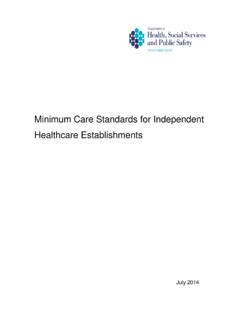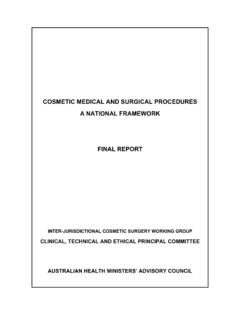Transcription of CATEGORIES OF HEALTH SERVICES - Jones & Bartlett Learning
1 2 Key Terms Department of HEALTH and Human SERVICES (DHHS) Public HEALTH Service (PHS) HEALTH promotion and illness prevention SERVICES Diagnosis and treatment Rehabilitation Healthcare facilities Managed care organization (MCO) HEALTH maintenance organization (HMO) CATEGORIES OFHEALTHSERVICES Preferred provider organization (PPO) Medicare and Medicaid Diagnosis related groups (DRGs) Informed consent HEALTH teams Public hospital Proprietary hospital Ambulatory care Mental HEALTH servicesObjectivesAfter studying this chapter, the student should be able the healthcare functions of private and public facilities, inpatient and outpatientservices, military facilities, and volunteer how healthcare systems are (b).qxd 7/27/08 7:58 AM Page 9 Jones and Bartlett Publishers, LLC. NOT FOR SALE OR DISTRIBUTIONC hapter 2 CATEGORIES of HEALTH the four major types of HEALTH SERVICES and their the functions of the two major providers of managed the concept of diagnosis related the major points of the Patient s Bill of public HEALTH , hospital, ambulatory, and mental HEALTH of the Healthcare SystemThe healthcare system is extremely varied.
2 Individual healthcare units, which attimes overlap, serve a variety of people based on their economic and social status. Individu-als and families receive and buy healthcare SERVICES based on what they perceive to be theirimmediate needs. At the present time, physicians in private practice direct delivery of healthcare. HEALTH care is primarily financed by personal, nongovernment funds or is paid directlyby consumers through private HEALTH insurance plans. Local and state governments providepublic HEALTH federal government provides very few HEALTH SERVICES directly, preferring to developnew, improved SERVICES by furnishing money to buy the developments it wants to seeexpanded. With minor exceptions Veterans Administration and the Indian HEALTH Ser-vice the federal government has no authority to provide direct SERVICES . This is a functionof the private sector and the states.
3 The federal government is involved, however, infinancing research and individual HEALTH care for the elderly and indigent (via Medicareand Medicaid).Congress plays a key role in this federal activity by making laws, allocating funds, anddoing investigative work through committees. The most important federal agency concernedwith HEALTH affairs is the Department of HEALTH and Human SERVICES (USDHHS).Theprincipal unit within this department is the Public HEALTH Service (PHS), which has eightagencies within its domain: National Institutes of HEALTH (NIH); Substance Abuse and Men-tal HEALTH SERVICES Administration (SAMHSA); Food and Drug Administration (FDA);Centers for Disease Control and Prevention (CDC); HEALTH Resources and SERVICES Admin-istration (HRSA); Agency for Healthcare Research and Quality (AHRQ); Agency for ToxicSubstances and Disease Registry (ATSDR); and the Indian HEALTH Service (IHS).
4 The PHSis described more completely later in this wide variety of healthcare facilities are available. These facilities, the places where per-sons involved in the healthcare industry work, are broadly summarized in this chapter and areindividually detailed in succeeding chapters. This discussion of the numerous healthcarefields should assist students in selecting a career and becoming knowledgeable about theirchosen healthcare industry is a complex system of remedial, therapeutic, and preventive serv-ices. Hospitals, clinics, government and volunteer agencies, healthcare professionals, phar-maceutical and medical equipment manufacturers, and private insurance companies providethese SERVICES . The healthcare system offers four broad types of SERVICES : HEALTH promotion,disease prevention, diagnosis and treatment, and (b).qxd 7/27/08 7:58 AM Page 10 Jones and Bartlett Publishers, LLC.
5 NOT FOR SALE OR DISTRIBUTIONH ealth promotion serviceshelp clients reduce the risk of illness, maintain optimal function,and follow healthy lifestyles. These SERVICES are provided in a variety of ways and include hospitals that offer consumers prenatal nutrition classes and local healthdepartments that offer selected recipients prenatal nutrition classes plus the foods that satisfytheir nutrient requirements (the Women, Infants, and Children [WIC] program). Otherclasses at both hospitals and HEALTH departments promote the general HEALTH of women andchildren. Exercise and aerobic classes offered by city recreation departments, adult educationprograms, and private or nonprofit gymnasiums encourage consumers to exercise and main-tain cardiovascular fitness, thus promoting better HEALTH through lifestyle prevention servicesoffer a wide variety of assistance and activities.
6 Educational effortsaimed at involving consumers in their own care include attention to and recognition of riskfactors, environmental changes to reduce the threat of illness, occupational safety measures,and public HEALTH education programs and legislation. Preventive measures such as these canreduce the overall costs of HEALTH the diagnosis and treatmentof illnesses have been the most heavily used of thehealthcare SERVICES . Normally people waited until they were ill to seek medical , recent advances in technology and early diagnostic techniques have greatlyimproved the diagnosis and treatment capacity of the healthcare delivery system but theadvances have also increased the complexity and price of HEALTH the restoration of a person to normal or near normal function aftera physical or mental illness, including chemical addiction. These programs take place in manysettings: homes, community centers, rehabilitation institutions, hospitals, outpatient settings,and extended care facilities.
7 Rehabilitation is a long process, and both the client and familyrequire extra assistance in adjusting to a chronic FacilitiesExpansion of the healthcare system and professional specialization has resulted in anincrease in the range and types of healthcare settings. A wide variety of healthcare facilitiesarenow available. The range includes inpatient, outpatient, community-based, voluntary, insti-tutional, governmental, hospice, and comprehensive HEALTH maintenance not requiring hospitalization can find HEALTH care in physicians offices, ambulatorycare centers, and outpatient clinics. Immediate care clinics exist as freestanding clinics orinside a pharmacy and are staffed by physicians, nurse practitioners or physician assistantswho treat minor acute illnesses such as colds, cuts, or sprains. Although physicians with officepractices focus mainly on diagnosis and treatment of specific diseases, many clinics and ambu-latory centers offer HEALTH education and rehabilitation as agencies provide HEALTH care to people within their defined neighbor-hoods.
8 Such diverse facilities as day care centers, home HEALTH agencies, crisis interventionand drug rehabilitation centers, halfway houses, and various support groups all work in a widevariety of ways to maintain the integrity of the that provide inpatient(persons admitted to a facility for diagnosis, treatment,or rehabilitation) SERVICES include hospitals, nursing homes, extended care facilities, andHealthcare Facilities1158233_CH02_Stan(b).qxd 7/27/08 7:58 AM Page 11 Jones and Bartlett Publishers, LLC. NOT FOR SALE OR DISTRIBUTION rehabilitation centers. Hospitals are the major agency in the healthcare system. They varygreatly in size, depending on location. A rural hospital may have two dozen beds; a hospitalin a large city may have more than a are either private or public. A private hospital is owned and operated by groupssuch as churches, businesses, corporations, and physicians.
9 private hospitals are operated insuch a way as to make a profit for their owners. A public hospital is financed and operated bya government agency, either at the local or national level. Such facilities are termed nonprofitfacilities, and they admit many clients who cannot afford to pay for medical care. Clients inprivate hospitals have insurance, private funds, or medical assistance to pay for their hospitals are usually nonprofit and often are owned and operated by religiousorganizations. Community hospitals are independent , nonprofit corporations consisting oflocal citizens interested in providing hospital care for their branch of the military operates and owns hospitals that provide care and treatmentfor military personnel and their families. The federal government operates Veterans Admin-istration (VA) and Indian HEALTH Service (IHS) hospitals and clinics.
10 The VA provideshealth care for veterans of the armed SERVICES . The IHS is responsible for providing healthservices to American Indians and Alaska Natives. The IHS currently provides HEALTH servicesto approximately million American Indians and Alaska Natives who belong to more than557 federally recognized tribes in 35 state operates hospitals that offer long-term care, if necessary, for treatment of thementally ill or retarded. These state hospitals are run by state administrative agencies. At thelocal level, district hospitals are supported by taxes from those who live in the district. Thesehospitals are not involved with the governments of cities, states, or counties. County hospi-tals are run by counties and provide SERVICES for the poor and private patients. City hospitalsare usually controlled by municipal and county governments. Many city hospitals providecare primarily for the professionals working in such widely different facilities encounter diverse chal-lenges that require them to become knowledgeable in specialized areas and to expand theirrange of SERVICES .















